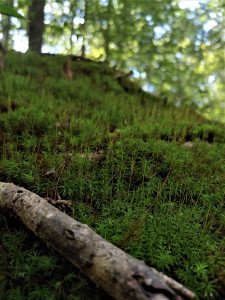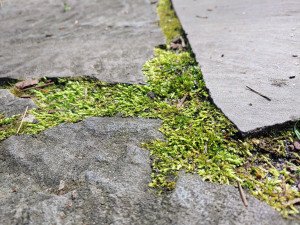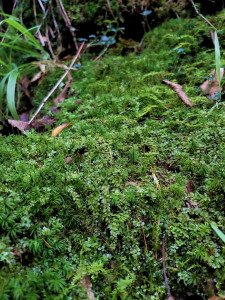On the clay slopes of ravines, clinging to the rocks in shallow streams, and deep in the cypress domes lie our native mosses. Minute green remnants from the first organisms to ever colonize land, the world of mosses is entangled with our everyday life but seems to remain on our peripherals. Inhabiting the margins between our world and the microscopic – the biology of all mosses is distinctly separate from that of 80 percent of the plants on earth – that of the vascular plants.
Common haircap moss (Polytrichum commune) is a highly adaptable moss, thriving in many soil types and from full shade to sun. Known for being a filter for heavy metals and superb for erosion control, here P. commune is holding together the vertical clay slopes by a stream in town. Photo by Louie Sandstrum.
True mosses are Bryophytes, a classification of plants that are defined by being nonvascular, organisms that have no vessels of their own to transport water or nutrients. Think of a tree stump. There’s a layer of woody bark, vessels in rings of tissue that make up the bulk of the tree, and the heartwood at the center. Mosses have no such features. This leads to two things – the lack of complex supporting structures means mosses are restricted to the boundary layer of the earth where the climate is most stable, but they are also free to have as much surface area as they can manage – with leaves often only one cell thick.
This combination makes moss as accessible to water as possible. Whether it is the humidity in the air, rainfall, or flowing from a nearby source, mosses need water to live. The physical movement of water over moss takes the role of vascular action, providing particles of nutrients and hydration directly to their cells. Even when completely dried out, most mosses will reabsorb water and seemingly come back to life, flushing back out into their original colors.
Bryophytes reproduce by spores rather than seeds, as no true moss flowers or fruits, but produce what is called a sporophyte – a spore-filled capsule on the end of a stalk. Water once again comes into play, acting as the main transportation for moss spores, though taller sporophytes can make use of the air. Mosses can also easily spread through any part of the plant – a leaf, stem section, or rhizoid (the moss version of roots) – massing a colony over time.
This flat glaze moss (Entodon cladorrhizans) lives in the cracks between a flagstone pathway under full sun and well-draining sand and yet can thrive in shaded water edges as well. Photo by Louie Sandstrum.
In a garden moss can shine. Thriving in areas that may seem harder to landscape, permanently wet and shaded areas that would otherwise be patches of mud can be redefined by some thoughtfully placed moss. Even the heavy freeze we experienced last Christmas means little to our mosses, protected by their proximity to the soil and coupled with a natural antifreeze, mosses often remain green even underneath a layer of snow. Being evergreen may tempt plant-eaters during the winter months, yet other internal processes create phenolic compounds, antiseptic toxins that act as a pesticide and deter herbivory.
All species of our native mosses are considered perennials, meaning they persist year after year, living anywhere from two to 10 years, though colonies can persist for decades. As long as you choose the right species for the spot in your yard, the main upkeep for a moss garden is weeding and brushing any fallen leaves off the carpeted surface. What matters most is the substrate a moss is established on. Some species grow only on bare rock, others in decaying matter, and some on the bark of living trees. Mosses aren’t restricted to only the wettest or shadiest of spaces either, there are species that grow in full sun and in every soil type.
The texture of saber-tooth moss (Plagiomnium ciliare) enhances that of the mosses around it. Mosses can commonly be seen cohabitating with other species – it would be easy to mistake P. ciliare for a vascular plant with its large leaves and creeping growth. Photo by Louie Sandstrum.
One of our natives, common haircap moss (Polytrichum commune), is found worldwide from the Arctic circle down through Mexico, a common trend for moss. These extensive ranges allow them to pair well with established natives in many landscapes. Partridgeberry (Mitchella repens) finds a foothold among saber-tooth moss (Plagiomnium ciliare) on a stream edge and mounding mosses like pincushion moss (Leucobryum glaucum) can add green to the area beneath a palmetto or Rhododendron. Any ponds bordered by wildflowers that die back in the cooler months can benefit by having an underlayer of moss to provide interest year-round. Wildlife makes use of moss as well; I have seen moss used by insects as places to sip water from their leaves without drowning and by several species of birds as a plush layer of nest lining.
To someone who has not been introduced to the world of mosses it can be easy to miss that which lives underfoot. Mosses can act as texture in planters, blanket rocks in a bird garden, provide greenery in water features, fill in between flagstone on pathways, as a ground cover in shady spots, or even as their own featured garden. In forests they provide similar services – reducing erosion and filtering water. It’s this versatility that makes our native mosses worth discovering in the wild and a delight in any yard.





